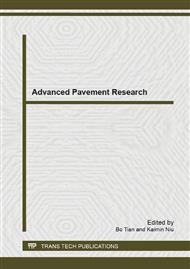[1]
Chatterji S., Freezing of air-entrained cement-based materials and specific actions of air-entrained agents, Cement Concrete Composites, 25 (2003) 759-765.
DOI: 10.1016/s0958-9465(02)00099-9
Google Scholar
[2]
L. Du and Kevin J. Folliard, Mechanisms of air entrainment in concrete, Cement and Concrete Research, 35 (2005) 1463-1471.
DOI: 10.1016/j.cemconres.2004.07.026
Google Scholar
[3]
X. Ouyang, Y. Guo, and X. Qiu, The feasibility of synthetic surfactant as an air entaining agent for the cement matrix, Construction and Building Materials, 22 (2008) 1774-1779.
DOI: 10.1016/j.conbuildmat.2007.05.002
Google Scholar
[4]
Yang Huaquan, Zhou Shihua, Su Jie, Effect of air void parameters on properties of air entraining concrete, Hydroelectric Power, 35 (2009) 18-19.
Google Scholar
[5]
Zhang Desi, Cheng Xiuzhen, Study on air void parameters of hardening of the concrete, Journal of Northwestern Polytechnical University, 20 (2002) 10-13.
Google Scholar
[6]
Wu Xueli, Yang Quanbing, Zhu Beirong, et. al. Evaluation of concrete frost resistance, Concrete, 120 (1999) 9-12.
Google Scholar
[7]
Junyi Li, Xiaoming Li, Caihong Xu, Estimate on the frost resistance of concrete by analytical method of air bubbles parameter of fresh concrete, Port & Waterway Engineering, 382 (2005) 5-8.
Google Scholar
[8]
John M. Stencel, Haiping Song, Federico Cangialosi. Automated foam index test: Quantifiying air entraining agent addition and interactions with fly ash-cement admixtures, Cement and Concrete Research, 39 (2009) 362-370.
DOI: 10.1016/j.cemconres.2009.01.010
Google Scholar
[9]
Jinxi Zhang, Mingyang Guo, Rongjun Yang , et. al, Effect of air-entraining admixtures on the structure and properties of hardened concrete, Journal of Wuhan University of Technology, 30(2008)38-41.
Google Scholar
[10]
Jinxi Zhang, Mingyang Guo, Rongjun Yang, Effects of high-frequency vibration on frost resistance of road concrete structure, Journal of Highway and Transportation Research and Development, 25 (2008) 55-58.
Google Scholar
[11]
Yanxia Liu, Gaixin Chen, Yihui Lu, Influence of high-frequency vibraiton on concrete air content, antifreeze and air bubble parameters, Journal of Hydroelectric Engineering, 28 (2009) 106-111.
Google Scholar
[12]
Hao Feng, Qingjiang Zhu. Manualof Engineering Application of Concrete Admixtures, China Architecture and Building Press, Beijing, 1999, p.218.
Google Scholar
[13]
Naiqian Feng. Applied Manual of Concrete, Science Press, Beijing, 2001, pp.616-618.
Google Scholar


